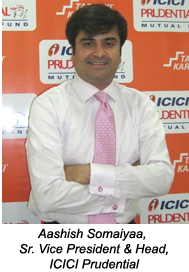Aashish Somaiyaa, Sr. Vice President & Head - Retail Business, ICICI Prudential AMC shares his perspective on the AMC’s latest offering—ICICI Prudential Bluechip Equity Fund.
 What kind of feedback are
you getting from your distribution partners on your NFO especially at a time
when there is so much uncertainty surrounding the Indian and US economies?
What kind of feedback are
you getting from your distribution partners on your NFO especially at a time
when there is so much uncertainty surrounding the Indian and US economies?
Distributors are definitely showing excitement and interest in carrying this product to their clients. It has a place in every client's portfolio. While uncertainty is a defining characteristic of any capital market, this is a product that needs to be looked at from a sound and grounded process rooted in asset allocation, goal planning and diversification across currency and economies.
Investors mostly look at the exchange rates before investing in any overseas fund. Is this the right time to take exposure to the dollar?
In the last one month, when I have been speaking to Indian investors about the need for investing in dollar assets via the ICICI Prudential US Bluechip Equity Fund, they have all been telling me, it’s a great product, excellent concept but we will make the move when the US dollar is cheaper. Now I don’t understand why a view on the rupee is so critical in making this investment decision.
If I had a portfolio with 50% allocation in dollar assets like US stocks, and 50% allocation to rupee assets like Indian stocks, and then I had to make a further allocation, I would be absolutely right in worrying about the exchange rate of switching from rupee to dollar and vice-versa. But here I am with every single rupee of mine in rupees (pun intended), and I am worrying "Uh oh, if the rupee appreciates I will lose out, so let me not buy dollar assets now." Instead of worrying about the rupee appreciating I should be losing sleep over the fact that I don’t have any asset in dollars, what will happen to me if rupee depreciates further.
If the view is that the rupee will appreciate, that means you have a positive view on Indian equity markets. So then I must see money moving into Indian equities, but that’s not happening either.
So what is the view? Let me tell you, there is no view. So if you are not investing in dollar assets because you have a strong view that the rupee will appreciate, you must create assets in rupees. But that too is not happening!
One school of thought is that if Indian markets are giving to 10%-15% returns, there is no need to diversify outside India. What are your views?
The only way to look at this is diversification. Let me have assets in some proportion in both asset classes. If I have a positive view on the Indian rupee, I have more allocation in India. In our case we have a staggering 100% allocation to India, and mind you, the rupee is depreciating real fast. If I have a negative view on the Indian rupee then I have more allocation to dollar assets. But in our case it is zero. If I have no view, I have some proportion in both—depending on my future goals. But we have no allocation to dollar assets. And I know for sure that two of our most important life goals depend on the dollar— foreign education for the child and international vacation for the wife.
The theories of finance in some way suggest that the long-term trend of the currency is determined by interest rate and inflation differentials. There is on average 6% to 8% difference in interest rates and inflation between us and the USA. And hence the rupee has been on a steady declining trend. I believe at Independence the currency was 7.5 to a dollar, in 1990 it was Rs 20 to a dollar, post liberalisation in 1991, it was 30 rupees to a dollar and so on and so forth.
When making any decision, it is important to focus on the cost of not making a decision, as much as one focuses on the costs of making that decision. And then as someone famously said, not making a decision is a decision in itself—that's not free of cost either.
How much are you planning to raise from this fund?
I think nowadays NFOs are all about introducing new concepts or ideas that help add value in the process of advising clients and provide some benefits on return enhancement and risk mitigation of some sort. Gone are the days when NFOs used to be a marketing blitz. Some of the products like Discovery, Focused Bluechip, Regular Savings Fund etc are today multiple times of what we collected in the NFO because they were sound scalable product ideas and it is irrelevant to discuss what came in the NFO. ICICI Prudential US Bluechip is a sustainable scalable idea which I see becoming big for us in the next 2 years. Having said so our product team led by Himanshu and investments team led by S Naren have received a lot of compliments for the idea and the unique product construct for giving Indians exposure to some of the leading global companies listed in the USA. So, I have a 2-year target of $300m to $400m in this product but no short-term target.
How are you marketing this fund?
Marketing of the fund has been more through newspaper ads, media coverage, outdoor, online promotions, etc. Like I said, the entire focus is more to explain the need for this product in a client's portfolio than to get each and every person invested in it. For long-term scalability of products, clarity of positioning is key. We need to tell advisors what place this should take in an investor's portfolio and what it aims to do for the investor on risk and return parameters.
What need will it serve in the investor’s portfolio?
In India when one invests into equity for the first time, one starts with the ‘A’ group of BSE. On a global calibration of stock markets, the USA is the so called A group. It has over 30% of world market cap and this product provides access to that set to Indian investors.
Lot of companies that derive their growth from India and other emerging markets are actually not listed here, and to participate in their growth, we have to invest where they are listed.
The product provides geographic diversification and currency diversification which brings in complementarity in the investor’s portfolio. We have seen that the US market has very low correlation to the Indian market and in simple terms, I can say I have seen data which shows that there are many years like last year when the Indian market has done badly and the US market has done relatively better. Not only that, we have noted that in these years, our currency has also depreciated.
Investing some part of our portfolio in dollar assets is a must. The US being a developed market is less volatile than our stock market - a case in point being 2008 when their market fell less than ours despite the crisis having originated there.




